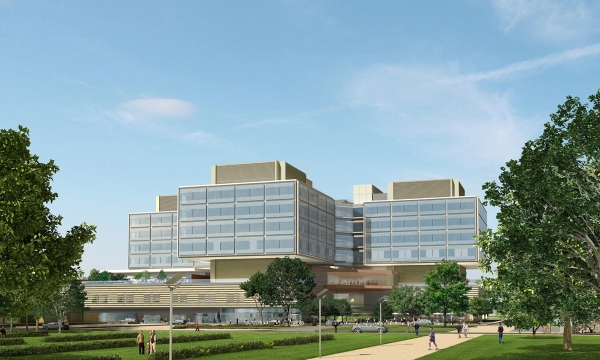After four years of hearings, debates and negotiations, Stanford University Medical Center's proposal to dramatically expand its hospital facilities in Palo Alto is now rounding the final corner en route to the city's approval.
Though the hospital expansion project -- the largest construction project in the Palo Alto's history -- still awaits the final approval from the City Council, over the past month Stanford and the city have resolved all of the major issues of dispute. Stanford's momentum continued Wednesday night when the city's Planning and Transportation Commission recommended approval of a critical environmental analysis for the hospital expansion.
The commission voted 4-2, with commissioners Arthur Keller and Susan Fineberg dissenting and Chair Samir Tuma abstaining, to recommend certification of the Final Environmental Impact Report for the Stanford project -- a massive document that lists the potential impacts of the hospital expansion and proposes ways to mitigate them. Keller and Fineberg both voted against the approval because they wanted more information before taking the vote.
While Stanford still has to clear several hurdles, officials from both the hospital and the city expressed optimism Wednesday about the progress made. At the beginning of four-hour-long discussion, officials from both sides lauded the recent progress of negotiations over a development agreement -- a document that would enable Stanford to exceed the city's zoning regulations in exchange for a series of community benefits.
"We've come a long way," said Michael Peterson, Stanford's vice president for special projects. "It's been over four years. I feel we're at a point where we can see the end of the process and the beginning of the hard work ... constructing a quite significant project."
Palo Alto Deputy City Manager Steve Emslie also said he was confident that the city is getting a fair deal from Stanford. As part of the proposed development agreement, Stanford would provide Palo Alto with $7 million in health-care programs and services, $23 million in fees for housing programs and $12 million for climate-change initiatives. Stanford would also buy Caltrain Go Passes for all hospital workers and give the city $3.4 million for improvements to bicycle and pedestrian paths near the hospital facilities.
Stanford had also agreed to guarantee the city $8.1 million to ensure the hospital expansion would not have a negative impact on the city's budget. The issue of "cost neutrality" was the final sticking point in negotiations. The two sides settled it last month.
"The city is very comfortable that we are able to provide the maximum amount of certainty that the project will stand on its own and continue to be revenue-neutral to the city throughout the life of the project," Emslie said.
The planning commission delayed its review of the development agreement until next week and focused Wednesday's discussion on the final Environmental Impact Report. The commission also approved a "statement of overriding consideration" -- a document that acknowledges that some of the project's impacts cannot be fully mitigated but that the good in the project outweighs the bad. Commissioner Eduardo Martinez said the main "overriding consideration" in this case is that the city is "receiving far more good than we are than we are losing in terms of the hospital that has to be torn down or some other item."
The commission, which had spent months reviewing the draft and final environmental documents, continued to raise some concerns about the hospital expansion and its impact on local housing and schools and Stanford's decision to demolish the historic Edward Durell Stone-designed complex. Some of these issues could re-emerge next week, when the commission reviews other components of Stanford's application.
The $3.5 billion project includes construction of a new Stanford Hospital & Clinics, the expansion of Lucile Packard Children's Hospital and renovation of various clinics and Stanford School of Medicine buildings. It would bring 1.3 million square feet of new development and about 2,200 new employees to the city.
To enable the construction, Palo Alto is revising its zoning map to create a new Hospital Zone especially for the Stanford project and allowing the hospitals to exceed the city's zoning regulations.
Stanford's journey toward the city's final approval has taken about four years and featured 95 public hearings, many of them centering on the project's design and its impacts on housing and traffic in Palo Alto. Over the past month, the project cleared a series of critical hurdles when the city's Architectural Review Board approved the proposed designs and a council committee endorsed the development agreement.
The Menlo Park City Council voted 4-0 Tuesday night to support the project after Stanford offered $3.7 million for traffic mitigation and other local improvements.
The Palo Alto council is scheduled to vote on the project in June.



Comments